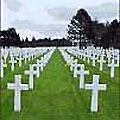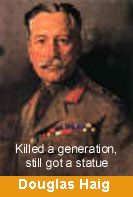
Excerpt from an editorial in the Brisbane Line, Brisbane, Australia
© The Brisbane Institute 1999-2001Author: Phil Dickie
Date: 07 May 2002The Brisbane Line doesn't much go in for editorials, but occasionally editor Phil Dickie can't help himself. Anzac Day set him brooding on a misty morning in northern France and the endless tragedy in the one time holy land.
One of the most vivid images of my life came unexpectedly upon me as a young teenage passenger in a van trundling down a country road in France early one winter morning. As the mist rose I became aware that the fields beside the road were filled with small white crosses. It was undulating land, and as the mist started to clear from the next rise, more lines of crosses appeared. And as the mist started to rise over a low and distant hill, those dreadful lines were still appearing out of the mist and disappearing out into the distance.
Thirty years on, my eyes still mist over at the memory of what that rising French mist revealed to me.
In the years since, I have never been able to precisely locate where I was. The Michelin mob do great detail on their road maps, but there are many roads in the area and most run past multiple cemeteries. Only some of the little crosses on the maps carry any further notation - Brit, Can, All. (German) or Aust. You presume that most of the unmarked ones are probably Fr.
Most likely, I was in the valley of the River Somme, where the British made their great push on the Western Front in 1916. The generals determined in advance that the Germans and all their defensive works would be completely demolished in a pre-attack bombardment that lasted eight days and could be heard in England. Accordingly, the troops were to climb out of their trenches, form up, and walk line abreast across no man's land. Cavalry were kept on hand to ride off in the direction of Berlin once the infantry had secured the trenches.
There were 20,000 Allied casualties in the first hour of the attack, 60,000 in the first day. British Field Marshal Douglas Haig persisted for about five months or 600,000 allied casualties. The deepest advance of the entire battle was a mere 12 kilometres, some of which was given back to the Germans after heavy snow. Haig, a former cavalry inspector noted for his view that "The machine gun is a much over rated weapon." got himself a memorial statue in London, astride one of the horses never called into play that day. Relatives of some of the thousands of allied soldiers ordered executed by Haig for declining to go over the top have for years run a fitful but futile campaign to have his statue torn down and melted into medals for the murdered.

This is just one classic example of the insanity of war. Some commentators note that back in England, philosopher and pacifist Bertrand Russell ended up in jail during the battle of the Somme, although he was immeasurably more sane and less of a threat to the continued existence of Imperial Britain than Haig. Other commentators note that the First World War was the last war in which the majority of casualties came from the military. Subsequent wars of the 20th century were to be waged as much if not more against civilians.
Them Days Home | Memorial | Honour Roll | Remembrance Poems | The Soldier